Carl Duzen: Copper's Transformative Effect
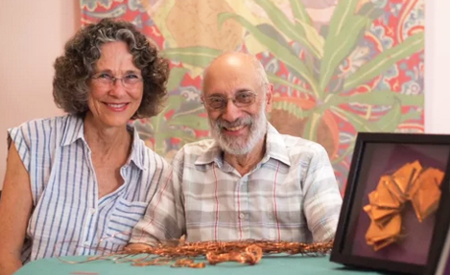 Carl Duzen and his wife Susan Jewett.
Carl Duzen and his wife Susan Jewett.Photograph courtesy of Susan Jewett.
When Carl Duzen, a former physics educator was diagnosed with Alzheimer’s disease in 2014, he and his wife, Susan Jewett, serendipitously turned to art to help them transition to this new stage of their lives in the most empowering way. The recent exhibition Carl Duzen: Copper. Denying Dementia Its Due at the Main Line Art Center in Haverford, PA was a result of their collaboration, consisting of more than 19 works of copper handformed by Duzen, and framed by Jewett.
The inspiration for the exhibit began when Duzen began extracting copper wire from electronics. He creatively rolled the wire into forms that caught eye of his wife, a life long artist.
“It was simple really,” says Jewett. “Carl has been deconstructing' electronic things for some time now, a year or more. It is one of the things he finds he can still do, and he loves using his hands. Additionally he has a workshop full of hand tools which he enjoys using.”
She soon began placing them against various backgrounds and in spatial relationships within art box frames.
“Of all the things coming out of the electronics Carl was disassembling, the copper was the most varied in form and color and size—the most beautiful, and the most interesting.”
While Carl’s art was born from a dementia diagnosis, it demonstrates the need for people with life altering diagnosis to create a meaningful path, maintaining hope and passion along the way. Jewett was inspired to collaborate with her husband to display these works in an exhibition to share with the world.
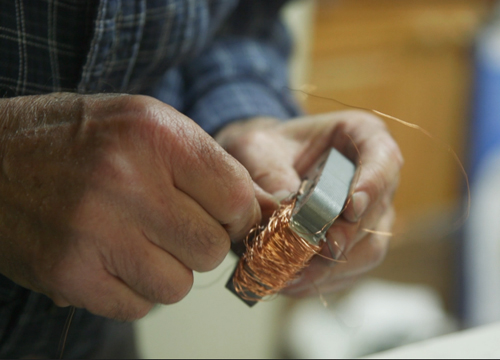 Carl Duzen handforming copper wire.
Carl Duzen handforming copper wire.Photograph courtesy of Susan Jewett.
“Mike Attie, independent film maker and Teya Sepinuck, Founder and Artistic Director of Theater of Witness both became interested in Carl's creative approach to his disease, looking for what he could do rather than what was lost to him, and became fascinated with this business of taking things apart,” she says. “The most beautiful things coming out of the old TVs, computers and other items, was the copper. Carl initially recognized it for its value as a recycling item, but Mike, Teya and I saw its beauty. One day, something clicked for me when I saw some bundled copper on Carl's workbench, and I went off to get some box frames. Before long we had 3, then 9, then 14 pieces framed and on display in our living room. Then I saw a notice at the Main Line Art Center about summer gallery rentals, and it seemed like a logical thing to do.”
According to Jewett, the exhibition has had a profound effect on their lives.
“Carl is a man with Alzheimer’s Disease, an illness which robs a person, bit by bit, of pretty much everything that makes him or her the person they know themselves to be,” she says. “I think the show was important to Carl because it is an affirmation of what he has been doing in response to his diagnosis. And what he has been doing is trying to go forward and find ways to live his life with continuing meaning and purpose. For me, the show was important because it allowed me to demonstrate to Carl, in a tangible and joyful way, my support for him as he, and we, travel down this particular rabbit hole. It gave us common purpose. In addition it allowed me to use my creative energies in a way I never imagined.”
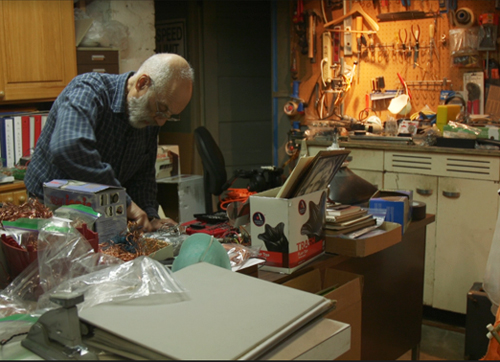 Carl Duzen working in his studio.
Carl Duzen working in his studio.Photograph courtesy of Susan Jewett.
Jewett says the show has created a great awareness of dementia in the artist community and beyond.
“There is no cure, and it is 100% deadly,” she says. “Research funding has been woefully lacking in comparison to other major diseases. Like cancer used to be, dementia has for years been a disease that was hidden away by families, somehow seen as shameful.
Jewett says that her husband took a different approach.
“From the outset Carl did not look for sympathy or weeping, just for understanding,” she says. “For both of us this is an increasingly lonely path. every day brings new challenges and small changes, adjustments that need to be made. It’s hard. So this show also gave our friends and neighbors an opportunity to face us directly and in a positive situation—to put an emphasis on what is rather than what is not.
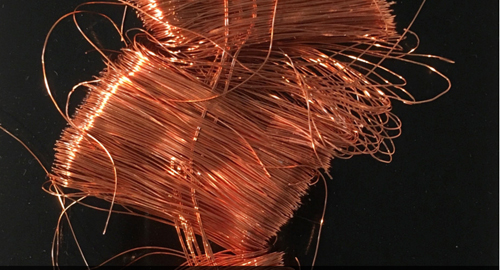 Closeup of Carl Duzen's copper wire work.
Closeup of Carl Duzen's copper wire work.Photograph courtesy of The Main Line Art Center.
On August 9, the show Carl Duzen: Copper. Denying Dementia Its Due opened to standing room only at the main Line Art Center in Haverford, PA.
“I was extremely gratified by the turnout on the night of the opening. We were enormously honored!” says Jewett. “I would hope that the connection between the art and dementia would leave people changed in their attitudes, that it might plant seeds of curiosity and maybe compassion, of interest and awareness.”
The show was a natural fit for The Main line Art Center. For more than 80 years, the Center has been nurturing the arts within the Philadelphia area and beyond through through outreach programs, art education and exhibitions.
“Our mission is art for everyone, regardless of age, disability, and economic factors,” says Amie Potsic, Executive Director and Chief Curator. “We partner with arts to have groups of artists with dementia to come to our galleries and have peer discussions about artworks."
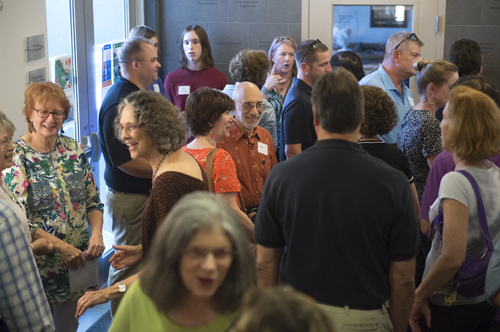 Carl Duzen and Susan Jewett at the opening of their exhibition.
Carl Duzen and Susan Jewett at the opening of their exhibition.Photograph courtesy of the Main Line Art Center.
A few years ago, ARTZ, the UPenn Memory Center and Mainline Art Center teamed up to create a program specifically for seniors with dementia, open to people of all ages.
“By talking about art, experiencing art firsthand and welcoming them to a very safe environment—which art is—it creates new memories,” she says.
Potsic says she is inspired by Carl’s outlook on life, and the way his work with copper has had a transformative effect.
“When his life changed and he had to adjust to living with Alzheimer’s, he took to that in a very positive way,” she remembers. “He decided to fight back and create a new sense of purpose---I think that’s very admirable. To come to a period in your life when you can’t use your skills in the way you used to, Carl really used his knowledge of science and engineering to create art.”
Potsic says people are drawn to the meaning and contrast copper creates in Carl’s work.
“The fact that the materials he’s using are copper has a lot of implications because copper has become so valuable—he is salvaging copper from electronics that are no longer usable, and upcycling copper to make new artwork. That’s something that’s so interesting because copper is so malleable—Carl has been able to make so many beautiful shapes and coils. I think that seeing how Susan has curated Carl’s sculptures into the suites into the frame with a dark background and how it sets off the copper is a beautiful contrast. You also can really see the handwork in it. The cool thing about how copper is so malleable—it’s both delicate and strong.”
Potsic was enthusiastic about the response of the show.
“What’s exciting is how people are responding to the work itself,” says Potsic. “I said to myself that it’s one of the most beautiful exhibits that we’ve ever done. We are looking forward to having them continue working and exhibition here—I think this is really just the beginning for them.”
Resources:
Also in this Issue:
- Carl Duzen: Copper's Transformative Effect
- Collage, Encaustics and Cold Wax: Sue Hohman’s Ways with Copper
- Kingfisher Designs: A Cauldron of Creativity
- Form Meets Function with Yucca Lane's Copper Coffee Pour Over
- Whistler and Contemporaries Featured in Reading Public Museum's Etching Revival Exhibition
